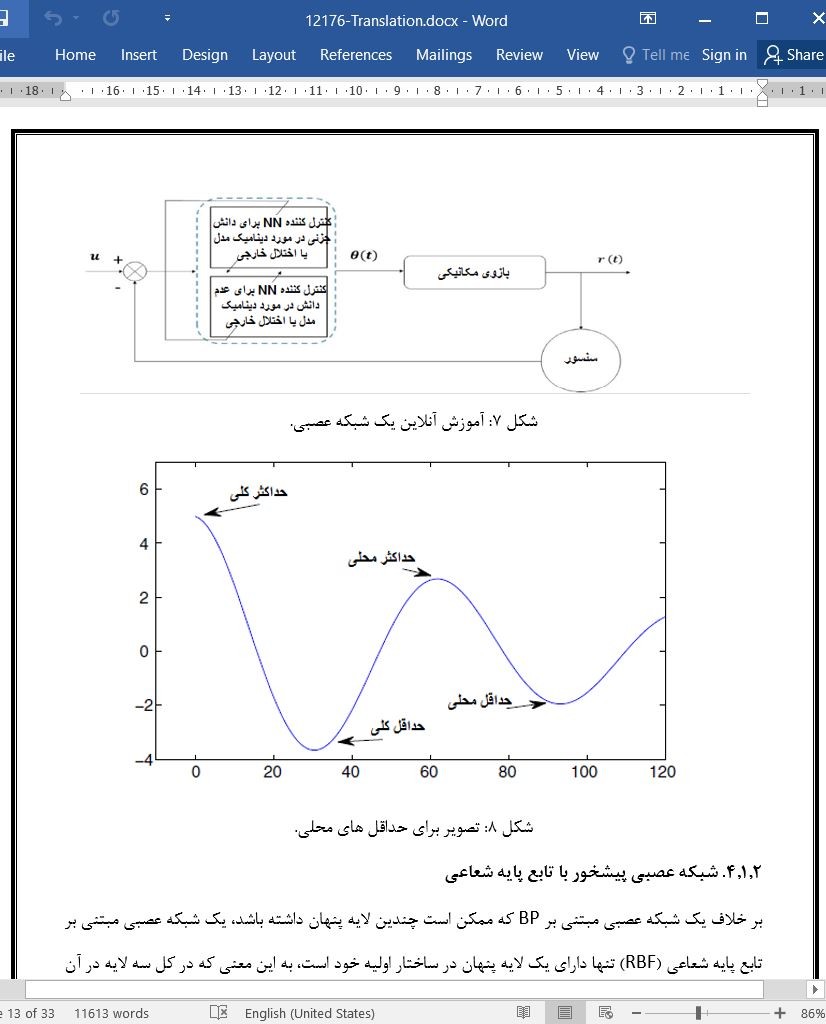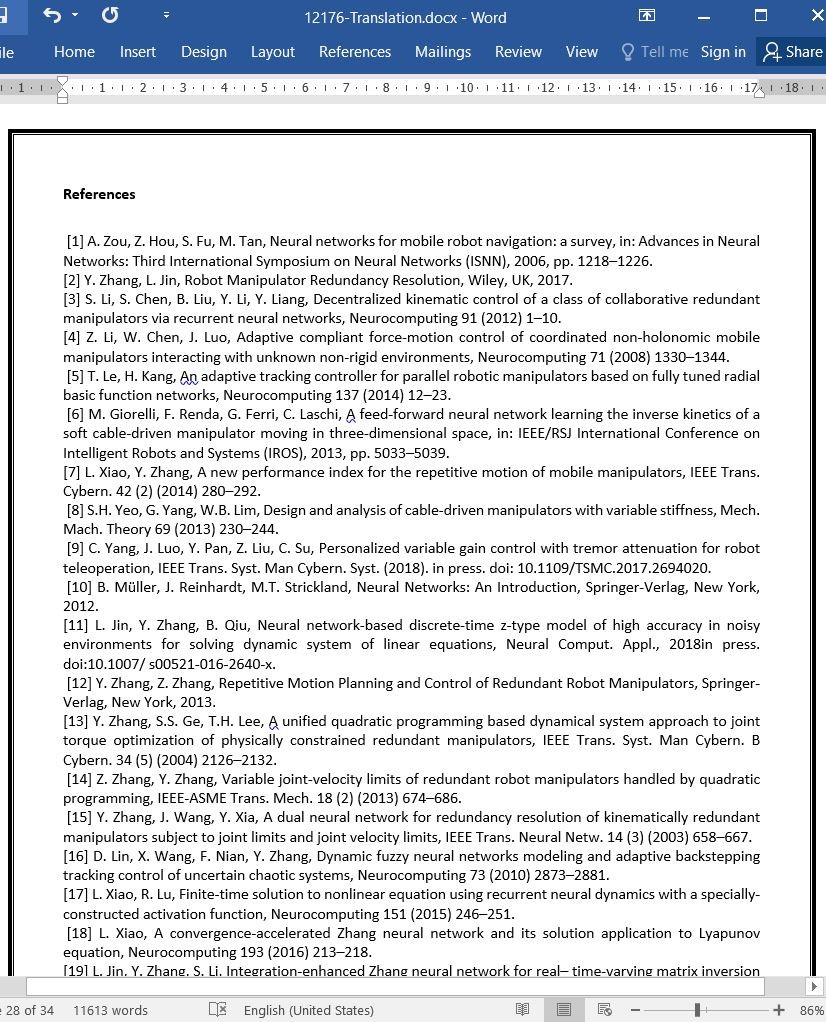
کنترل بازوی ربات با استفاده از شبکه های عصبی
چکیده
در سال های اخیر، بازوهای ربات نقش بسیار مهم و قابل توجهی در تحقیقات علمی و برنامه های مهندسی ایفا کرده اند. استفاده از بازوهای مکانیکی برای صرفه جویی در کار و افزایش دقت، در حال تبدیل شدن به شیوه های معمول در صنعت هستند. شبکه های عصبی، که پردازش موازی توزیع شده با سرعت بالا را نشان داده و می توانند به راحتی توسط سخت افزار اجرا شوند، به عنوان یک ابزار قدرتمند برای پردازش بلادرنگ شناخته شده و به طور گسترده و موفقیت آمیز در سیستم های مختلف کنترل به کار گرفته شده اند. به طور خاص، استفاده از شبکه های عصبی برای کنترل بازوهای ربات توجه زیادی را به خود جلب کرده و طرح ها و روش های مختلفی در رابطه با آن پیشنهاد شده و مورد بررسی قرار گرفته است. در این مقاله، ما به بررسی پیشرفت های تحقیقاتی در مورد کنترل بازوی مکانیکی از طریق شبکه های عصبی می پردازیم. مسئله ايجاد كنترل دستكاري و ايده هاي تئوری در مورد استفاده از شبكه عصبي براي حل اين مسئله، ابتدا آنالیز شده و سپس آخرین پيشرفت ها در اين زمينه در سال هاي اخير به طور كامل شرح داده شده و مورد بررسی قرار گرفته است. در نهایت، برای کاربردهای عملی، برخی از جهت گیری های بالقوه که احتمالا شایسته تحقیق در کنترل بازوهای مکانیکی با استفاده از شبکه های عصبی هستند، ذکر شده و مورد بحث و بررسی قرار گرفته اند.
6. نتیجه گیری
به طور خلاصه، دستاوردهای بزرگ کنترل بازوهای مکانیکی با استفاده از شبکه های عصبی، در دو دهه گذشته به دست آمده است. با این حال، هنوز مشکلات جدید بسیاری وجود دارد که باید حل شوند. تمام این پیشرفت های مربوط به آینده، با توسعه تولید پیشرفته و مواد برای انواع مختلف بازوهای ربات و همچنین نظریه ریاضی برای ساخت و توسعه شبکه های عصبی همراه خواهند بود. باید در نظر گرفت که انواع مختلف شبکه های عصبی، محدوده های عملی خود را دارند و نمی توان انتظار داشت که تنها چند نتیجه موجود در مورد شبکه های عصبی بتوانند از عهده تمام مشکلات کنترل موجود در بازوهای مختلف با وظایف مختلف برآیند. هر نوع از شبکه های عصبی، به عنوان مثال، شبکه های عصبی پیشخور، شبکه های عصبی بازگشتی، شبکه های عصبی دوگانه و همچنین اصلاحات آنها، مزایای خاص خود را دارند، که مبادلات مختلفی را بین پیچیدگی محاسباتی و بازده برای کنترل بازوهای ربات در نظر گرفته اند. در نهایت، به دو مسیر احتمالی تحقیقاتی آینده در مورد کنترل بازوهای ربات با استفاده از شبکه های عصبی اشاره شده است، که ممکن است دری برای تحقیق در مورد این موضوع باز کنند.
Abstract
Robot manipulators are playing increasingly significant roles in scientific researches and engineering applications in recent years. Using manipulators to save labors and increase accuracies are becoming common practices in industry. Neural networks, which feature high-speed parallel distributed processing, and can be readily implemented by hardware, have been recognized as a powerful tool for real-time processing and successfully applied widely in various control systems. Particularly, using neural networks for the control of robot manipulators have attracted much attention and various related schemes and methods have been proposed and investigated. In this paper, we make a review of research progress about controlling manipulators by means of neural networks. The problem foundation of manipulator control and the theoretical ideas on using neural network to solve this problem are first analyzed and then the latest progresses on this topic in recent years are described and reviewed in detail. Finally, toward practical applications, some potential directions possibly deserving investigation in controlling manipulators by neural networks are pointed out and discussed.
6. Conclusions
In summary, great achievements for the control of manipulators by means of neural networks have been gained in the last two decades. However, there are still many new problems to be solved. All these future developments will accompany the development of the advanced manufacture and material for various kinds of robot manipulators as well as the mathematical theory for constructing and developing neural networks. Keeping in mind, different kinds of neural networks have their own feasible ranges, and one cannot expect that only a few existing results on neural networks can tackle all the control problems existing in different manipulators with different tasks. Every class of neural networks, for example, feedforward neural networks, recurrent neural networks, dual neural networks as well as their modifications, has their own advantages, which has considered different tradeoffs between computational complexity and efficiency for the control of robot manipulators. Finally, two possible future research directions on control of robot manipulators using neural networks are pointed out, which may open a door to the research on this topic.
1. مقدمه
2. مقدمات
3. بازوهای ربات مختلف
3.1. بازوهای اضافی
3.2. بازوهای موازی
3.3. بازوهای کابلی
3.4. بازوهای متحرک
4. روش های شبکه عصبی برای کنترل بازوی مکانیکی
4.1. شبکه عصبی پیشخور
4.1.1. شبکه عصبی پیشخور مبتنی بر انتشار معکوس
4.1.2. شبکه عصبی پیشخور با تابع پایه شعاعی
4.2. شبکه عصبی بازگشتی
4.2.1. شبکه هاپفیلد
4.2.2. شبکه عصبی اسپایکی
4.2.3. ژنراتورهای الگوی مرکزی
4.2.4. شبکه حالت اکو
4.3. شبکه دوگانه
4.4. نظریه های کنترل مدرن و تکنیک های پیشرفته
5. بحث در مورد جهت گیری های آینده
5.1. برنده همه چیز برای کنترل بازوی مکانیکی
5.2. حافظه کوتاه مدت بلند برای کنترل بازوی مکانیکی
6. نتیجه گیری
منابع
ABSTRACT
1. Introduction
2. Preliminaries
3. Various robot manipulators
3.1. Redundant manipulators
3.2. Parallel manipulators
3.3. Cable-driven manipulators
3.4. Mobile manipulators
4. Neural network methods for manipulator control
4.1. Feedforward neural network
4.1.1. Feedforward neural network based on back propagation
4.1.2. Feedforward neural network with radial basis function
4.2. Recurrent neural network
4.2.1. Hopfield network
4.2.2. Spiking neural network
4.2.3. Central pattern generators
4.2.4. Echo state network
4.3. Dual network
4.4. Modern control theories and advanced techniques
5. Discussion on future directions
5.1. Winner-take-all for manipulator control
6. Conclusions
References
- اصل مقاله انگلیسی با فرمت ورد (word) با قابلیت ویرایش
- ترجمه فارسی مقاله با فرمت ورد (word) با قابلیت ویرایش، بدون آرم سایت ای ترجمه
- ترجمه فارسی مقاله با فرمت pdf، بدون آرم سایت ای ترجمه



